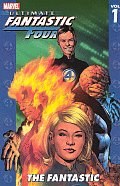Fantastic Four, from the John Byrne era, was the superhero comic that got me hooked on reading and following superhero comics rather than treating them as an occasional diversion at the beach. After reading the Ultimate Spider-Man Collection thanks to a friend and deciding that Marvel's Ultimate universe was interesting enough to give a chance, I of course had to check out what they did with my former favorite comic.
Written by Brian Michael Bendis (the same writer as Spider-Man) and Mark Millar, this trade paperback edition is subtitled The Fantastic and reprints issues #1 through #6. (The hardcovers may include more comics despite having similar names. I haven't kept track of Marvel's scheme.) It's just the origin story, explaining how Reed, Sue, Ben, and Johnny met and gained their powers and telling their first adventure. As with the other Ultimate books, the story shares elements from the start of the original Fantastic Four series in 1961 but updates it considerably, pulls in plot elements from much later books, gives the plotting an overhaul, and makes the science fiction current.
It's impossible for me to review this story from the perspective of a new reader. The primary appeal for me is to see a much better telling of an old and very familiar story, see how Bendis and Millar mix and match ideas, and ponder what I think of the differences. I thought I'd dislike the much younger Reed, but despite a cliched and annoying introduction (I'm very tired of the abused geek stereotype), it mostly works. Reed is the weakest of the four in characterization, though; here, he's upstaged by Sue (even though she does the damsel in distress routine, she still has far more personality than Sue started with in the original series) and Johnny. Ben is, as always, the best personality, although he doesn't start to shine until the end of the story. The personalities are recognizable but less cliched; they work as new characters, but work even better as nods to the memories of readers of the first series.
As for the origin story itself, pulling in the Negative Zone at the start and using it as the source of the Fantastic Four's powers works far better than the unimaginative cosmic ray business of the original series. The Mole Man also worked about as well as the Mole Man ever works, and the writing team deserves a lot of credit for pulling that off. One of the challenges of retelling early FF is that Mole Man (their first major villain) is a rather pathetic villain compared to the more cosmic and SF villains introduced later in the series. Here, he got a nice technological twist and as much character as I've ever seen for him. I still would have rather seen Galactus, Dr. Doom, or a Kree/Skrull war, but it was nowhere near as bad as it could have been. Bendis and Millar also did a great job weaving Victor Von Doom's start into the story without being too blatant about it. (The conclusion of that thread is left for future stories.)
The plot is cliched and interesting mostly for comparison purposes up until the point where all of the FF get their powers and get together (about halfway through). Then, Ben comes into his own and steals the show for the rest of the book. All of the FF are handled well, but this is one of the best takes on the Thing I've read. Ben is angry, annoyed, sarcastic, impulsive, and utterly likeable. There are several exchanges with the rest of the team that had me laughing out-loud. The rest of the story is mostly a curiosity, but the handling of Ben, the fight against the Mole Man's monster, and the refreshingly to-the-point conversation between Reed and Sue have me considering buying future volumes.
The art by Adam Kubert is in a similar modern, clear, dynamic style as Ultimate Spider-Man. At its worst, it can make faces and expressions look cartoonish, but the style works great for the technological marvels of the Baxter building. Kubert makes good dramatic use of full-page spreads and panel variations, giving the story the right larger-than-life feel of spectacular technology and rampaging monsters. The scene of the FF climbing down into the Mole Man's tunnels is a highlight of the collection, both for the art and for the writing. I do wish, though, that Kubert (and the rest of the art team) would have come up with something more visually interesting for the Negative Zone than huge panels of reddish pink, however well-colored.
This was a fun bit of nostalgia for me, and given how much I like Dr. Doom as a recurring villain, I may have to pick up the next volume to see how his story starts. I'm not sure if it would be as interesting to someone without my good memories of the Fantastic Four, but I expect Ben's banter will be a hit with almost everyone. This isn't the graphic novel to pick up if you're looking for subtlety in storytelling or deep characterization, but it's solid classic superhero writing with a modern face and a lot of appeal for anyone who followed Fantastic Four during its golden days.
Reviewed: 2007-03-01
